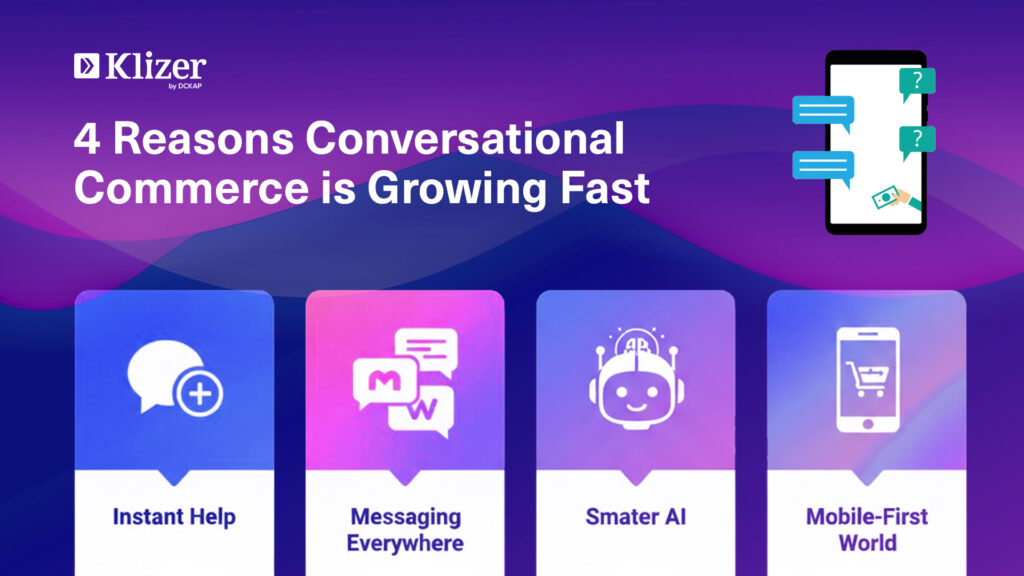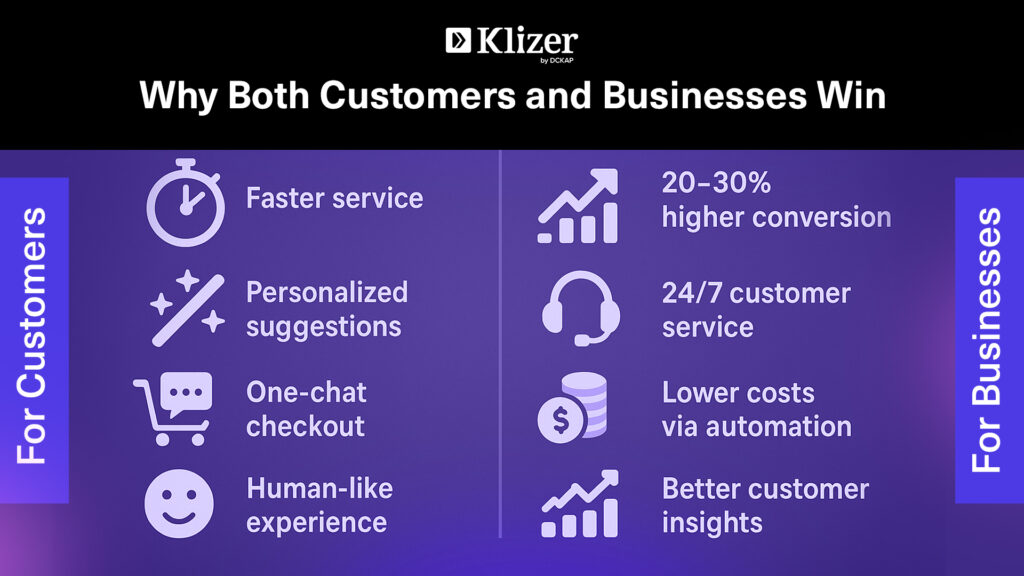Online shopping is experiencing very rapid changes. Nowadays, customers do not necessarily visit the retailer’s site, spend a lot of time there looking around, and then decide to buy. Rather, the customer may open up WhatsApp, raise a product-related question very briefly, and make the purchase right then and there.
This growing trend is referred to as conversational commerce and it is revolutionizing digital interactions among different sectors.
ON THIS PAGE
Understanding Conversational Commerce
Conversational commerce is the blend of shopping and conversation. It lets the customers communicate with the brands via chat, messaging or voice and they can do that for asking questions, getting product suggestions, and even completing the sale.
In simple words, we can say it’s shopping through conversation.
That conversation can happen on:
- Messaging platforms like WhatsApp, Facebook Messenger, or WeChat
- Voice assistants such as Alexa, Siri, or Google Assistant
- Websites or applications having chatbots deployed
This strategy gives the customers a feeling of being in the store and talking to a salesperson rather than just browsing through an online catalog.
Why Conversational Commerce Is Growing
Many factors, such as technology innovations and changes in consumer behavior, have contributed to the rise of conversational commerce as one of the most exciting trends in the digital commerce space.

1. Instant and Personal Interaction
Fast and personal service is what customers are looking for and that is what they get with messaging. No longer do people have to wait for email replies or fill out forms, they simply ask and get an instant answer, regardless of the time of day.
2. Messaging Apps Are Universal
There are billions of users who have already started using the messaging platforms. WhatsApp has more than 2 billion monthly active users all over the world, according to Statista, 2025.
3. AI Makes Conversations Smarter
The advances in artificial intelligence and natural language processing have increased the capabilities of chatbots significantly. They can find out the purpose of the communication, remember past interactions, and provide relevant suggestions based on the situation — frequently with no human participation.
4. Mobile-First Shopping
Smartphones account for over 80% of all ecommerce traffic. The features of conversational interfaces are suitable for mobile users, thus facilitating the shopping process on small screens.
The Market at a Glance
The numbers indicate how fast the conversational commerce trend is growing globally:
The worldwide conversational commerce market will go up from USD 8.8 billion in 2025 to USD 32.6 billion by 2035, henceforth experiencing a 14.8% annual growth rate (Future Market Insights, 2025).
These figures are nothing but a confirmation of the whole thing that many companies already see — that conversational experiences no longer belong to the experimentation stage, but are gradually becoming a standard practice in digital commerce.
How Conversational Commerce Works
Let us have a look at a few practical examples in the current consumer market where it is showing up:
Chat-Based Shopping
One customer sees a pair of shoes Instagram ad. Instead of going on a long product page, he starts a conversation on WhatsApp. The person inquires, “Is there size 8 available?” The chatbot verifies stock, shows color options, applies a discount, and sends a payment link — all within the conversation.
On-Site Assistance
A customer visits a website and a chatbot welcomes him/her: “Looking for something specific?” The customer says, “I want a laptop for design purposes under the price of ₹70,000.” The bot recommends the models, gives the specifications side by side, and assists in the transaction.
Voice-Enabled Shopping
A person says to his/her smart speaker, “I want my regular coffee beans.” The assistant gets the brand and price statement and processes the payment; thus, the order is complete.
Benefits of Conversational Commerce for Businesses and Customers

For Customers
- Faster service: No more queuing, just instant responses.
- Personalized suggestions: Every recommendation comes from the previous purchases or personal preferences.
- Simple checkout: One chat is enough for the whole purchase process.
- Natural experience: It is like talking to a real person, not filling out forms.
For Businesses
- Higher conversion rates: There are shorter journeys from question to purchase. Some studies report a 20–30% rise in conversion rates via conversational experiences.
- 24/7 support: Bots can serve several customers simultaneously, all day long.
- Lower service costs: Automation will take over routine queries, thus freeing up time and resources.
- Better insights: Interactive data will provide companies with knowledge about customers’ wants and, hence, facilitate better interactions in the future.
Conclusion
Conversational commerce is changing the way people shop online by making it faster, easier, and more personal. Customers can ask questions, get suggestions, and complete purchases through chat, messaging apps, or voice assistants, without going through long product pages. This not only helps buyers but also helps businesses sell more, save time, and understand their customers better.
For smooth implementation, work with an enterprise eCommerce solution partner like Klizer.









